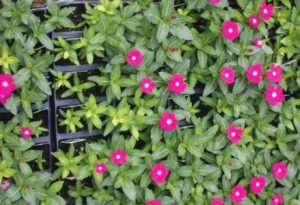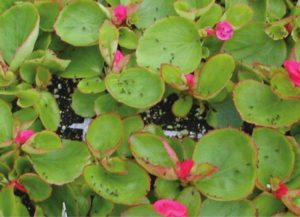Dealing with Black Root Rot
With the hot weather upon us, and fall pansy season just getting going, it is time once again to focus on preventing and controlling that dreaded disease, Thielaviopsis, or most commonly called black root rot.
For those of you who have grown fall pansies in the past, whether plugs or finished plants, you know what damage this disease can cause while the weather is hot. Losses in pansies and violas can occur in the plug trays, but more commonly will show up in the finished containers, whether flats or pots. While most of the focus on this disease is during the fall season, there have been many reports of Thielaviopsis on spring crops such as vinca, petunia and calibrachoa. Other crops that are susceptible to black root rot include poinsettias, geraniums (including hardy geraniums), diascia, fuchsia, snapdragons, dicentra, heuchera and phlox.
Symptoms and Diagnosis

Generally, plants infected with Thielaviopsis do not die suddenly, but may first show symptoms resembling nutrient deficiencies. Lower yellow or purplish leaves, like you would see with nitrogen or phosphorus deficiencies, can be the first sign (Figure 1). On some crops, it may show up as upper yellow leaves, similar to iron deficiency (Figure 2). Stunting of plants then occurs, and ultimately, death of the plant. First step is to always look at the roots! Thielaviopsis will show black sections on roots, not just from the root tips like you would see with Pythium (Figure 3). You can wash the roots carefully and look for black spores under a microscope or find black longitudinal areas within the roots. That is how you can distinguish Thielaviopsis from Pythium. I would, however, always send in samples to a disease diagnostic lab for confirmation.
How Disease Spreads and Conditions That Promote It
Thielaviopsis produces two main types of spores. Conidia can be abundantly produced and spread by splashing water, wind and within soil. Research has shown that these spores can also be picked up on the bodies of fungus gnats and shoreflies and spread to other containers (Figure 4). Chlamydospores are long-lived spores that can survive within soil for several years, and are also resistant to incomplete disinfection of greenhouse benches, walkways and containers.
Spores in the soil can be spread by wind or with feet of people walking in and out of greenhouses. Thielaviopsis chlamydospores are present in field soils, and so can easily be transferred into clean areas if sanitation procedures such as footbaths or washing floors routinely are not done properly. So, expect to find spores in your headhouse where your flat and pot-filling operations take place. Do not scrape up growing media that falls on the floor and put back into soil hoppers. Also, cover soil hoppers at end of day when workers are sweeping the floors.

Another way these long-lived chlamydospores are spread is through reusing plastic trays and containers. Growing operations that reuse these containers generally wash them to remove old soil and then dip or spray them with a disinfectant. However, I imagine there are operations that do not wash and disinfect reused plastic containers or water saucers as they feel as though they have had no previous problems with Thielaviopsis or any diseases
such as Pythium, Phytophthora, Fusarium and Rhizoctonia, all of which have long-lived spores.
What tends to happen with Thielaviopsis is that one year you may see just a little bit of disease, but not enough to be concerned. The next year you start to see more, especially after plugs or liners have been transplanted. By the third year, the problem is serious — all because reused containers and trays were not washed and disinfected properly.
Thielaviopsis is a stress disease, which means the susceptible plant must be under some kind of a growing stress for the fungus to infect and really colonize the roots. When isolated under lab conditions, this fungus grows very slowly, whereas Pythium grows very rapidly. When plants are grown under optimum conditions, Thielaviopsis is not strong enough to overtake the plant.
Stresses include high growing temperatures (fall pansies and violas), cool growing temperatures (vinca, petunia, calibrachoa), high media EC and too wet growing media. Thielaviopsis becomes more of a problem when growing media pH is greater than 6.5, at which crops such as vinca, pansy, petunia and calibrachoa do not like. One common problem with this disease in vinca is when plugs are held longer than planned. The vinca roots themselves start pushing up the media pH to levels the plant does not like but Thielaviopsis does. So make sure not to hold vinca plugs past planned shipping or transplanting dates.

Control Strategies
Control of Thielaviopsis starts with sanitation and prevention, as fungicides will only protect, not eradicate, this disease. As mentioned previously, the long-lived chlamydospores are in the soil particles outside that can be tramped into the headhouse. Avoid blowing dust from floors into soil hoppers as well as not scraping up growing media from floors and dumping back into soil hoppers. If using footbaths, clean them at least every day and use fresh disinfectant daily. Keep floors clean at least weekly by removing any soil and plant material that fell down on the floors and spray down with disinfectant (do not get on plants!). Clean benches after every crop by washing off loose soil and spraying down with one of the above disinfectants. Strip-It can also be used on any surface for cleaning, but avoid getting on plants.
If reusing plastic plug trays or containers, then make sure you wash them thoroughly before disinfecting them. All labeled disinfectants will lose activity the more organic matter (growing media) is on the plastic surface or in the dipping tank. Use new plug trays or containers for crops susceptible to Thielaviopsis. If you cannot do this, then use a strong enough disinfectant concentration for long enough time to kill all the chlamydospores that may be there. Research by Warfield and Konczal (2003, Survival of Thielaviopsis Spores on Re-used Plug Trays and Efficacy of Disinfestants on Spore Viability, SNA Research Conference 48:545-547) showed that power- washing trays greatly increased effectiveness of Greenshield dip or ZeroTol sprays in killing spores. ZeroTol needed to be sprayed at 2.5 oz/gal rate to achieve total kill. Greenshield needed to be at 1 tablespoon/gal rate for either 10- or 20-minute dip after power- washing to kill most all spores. Pay attention to how long the Greenshield is still active in dip tanks, as lack of foaming action indicates time for new solution. A 10 percent bleach solution in a 10-minute dip killed all spores whether trays were washed or not, but bleach is too dangerous for workers to use in closed spaces. Also, begonia plugs are very sensitive to reused plug trays disinfected with bleach.

For costly hard-plastic plug trays, the kind that work well with robotic transplanters, the best disinfection procedure is steam-sterilizing at 160° F for one hour in the middle of the stacked plug trays. Any shorter time or lower temperature will not be enough to kill all of the Thielaviopsis spores that may be clinging to the plug trays. Once treated, remember to cover all stacked trays on pallets with shrink-wrap on top and sides so no dust blows back on them.
Reducing growing stresses on susceptible crops is a great way of avoiding Thielaviopsis infection, even if you have not been able to do the above procedures. However, that is hard to do when you need to grow pansy and viola plugs and finished plants in hot and humid weather, or grow vinca when it is tough to keep soil temperatures above 65° F.
Practice good moisture management by avoiding too wet conditions, especially with cool soil temperatures. Monitor media EC and water through soil column to keep salts from building up. If your water quality is high in EC (greater than 0.75), then leaching with each watering or feeding is absolutely essential. Keep media pH below 6.5 by measuring susceptible crops weekly, using acid fertilizers when needed, using acid injection if water alkalinity is greater than 80 ppm for plugs and greater than 120 ppm for finished containers, and checking the lime rates in the growing media to start, whether you are mixing your own soil or buying in.
Avoid holding vinca plugs longer than planned, as media pH increases with more roots. Control fungus gnats and shoreflies which can spread spores from infected areas to non-infected areas. A combination of proper moisture management, clean floors, algae control, and weekly or biweekly soil applications of nematodes, Citation, Molt-X or Azatin will help control fungus gnats and shoreflies.
A problem I see some growers make is to transplant plugs or liners that do not have good healthy root systems (Figure 5), either hoping they will get better after transplanting or not paying attention. This usually happens with robotic transplanters which cannot select out those bad plugs. If the roots are bad, then do not transplant the plug or liner! It is that simple, but hard to implement with everything that needs to be done within the day or week.
Finally, there are some fungicides and biofungicides that can help protect roots of susceptible crops, but will not eradicate the disease. If you already have diseased plugs or plants, then remove them first and treat the rest to protect them. Do not transplant a healthy plug or liner back into the pot or container that you just removed diseased plants from, as the spores will still be there. Biofungicides such as Rootshield Plus may help to protect roots when introduced early in the crop cycle, but will not protect when stresses are increased or when spore numbers are high. Chemical fungicide drenches are limited in number and rotation should be done with applications every three to four weeks, no closer. Effective protectant fungicides include Cleary’s 3336 or any thiophanate-methyl fungicide (MOA 1), Affirm (MOA 19), Medallion (MOA 12), Terraguard or Trinity (MOA 3), Empress (MOA 11) or Orkestra (MOA 7+11). Again, if plants are already infected, these fungicides will not clean them up, so focus on prevention and protection.
Remember, Thielaviopsis or black root rot spores can be everywhere, but that does not mean they will infect your crop. Focus on practicing good moisture management, avoid high media EC, and give the crops the best temperature to grow, focusing on soil temperature, not just air temperature. I see problems in the winter and spring seasons with growers who have cold water reducing soil temperatures more than they thought and air temperature will not give any indication of this problem. Keep media pH less than 6.5, clean and disinfect reused plastic trays and containers properly, practice good sanitation procedures in headhouse and greenhouse, and use effective fungicides in proper rotation as protectants.
Finally, do not transplant bad plugs or liners! Hopefully, you can get through another hot summer and fall season with no problems from the dreaded black root rot (Thielaviopsis).


 Video Library
Video Library 




















